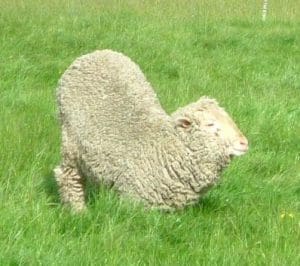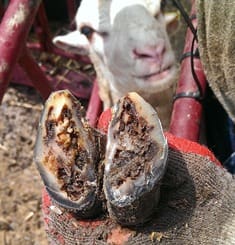
A sheep affected by virulent footrot.
AUSTRALIAN footrot researchers will test potential vaccine antigens for the serious sheep hoof disease using a new field-based infection system.
A Meat & Livestock Australia-funded collaborative research project between Monash University and the University of Sydney has identified five potential vaccine antigen candidates and will the soon start further testing and refinement of vaccine formulations.
The research team has used reverse vaccinology, an approach successfully applied in human medicine, to identify the vaccine antigen candidates.
MLA program manager health welfare & biosecurity, Dr Johann Schröder, said one of the problems with conventional footrot vaccines is that there are 10 variants of the major protective antigen.
“That means if you vaccinate against one strain of the bacterium that causes footrot, it doesn’t protect the sheep against the other nine. What we’re trying to develop is a vaccine that is cross-protective – one that will work against all of the causative bacteria,” Dr Schröder said.
Professor Julian Rood from the Monash Biomedicine Discovery Institute said the concept is based on sequencing the complete genome of the causative organism and using that sequence to identify its proteins.
“From 1300 potential proteins, we narrowed the list down to about 90 with potential as vaccine antigens,” Professor Rood said.
Proteins were purified using high-throughput technology and tested in pen-and-field vaccination trials for their ability to protect sheep against footrot.
The collaboration has included Monash BDI’s Dr Ruth Kennan and University of Sydney’s Dr Om Dhungyel and Professor Richard Whittington.
“Monash BDI has done the genomic and protein work, while the University of Sydney has done the vaccine work, and the collaboration has been very productive,” Professor Rood said.
“In the process of finding potential vaccine candidates, our colleagues at the University of Sydney have refined a field-based testing system.
“An important development was a reproducible, irrigated, pasture-based, natural infection model,” he said.
“It’s been used to test the effectiveness of vaccines in the field.”

Hooves affected by virulent footrot.
Footrot is an infectious and contagious hoof disease caused by the bacteria, Dichelobacter nodosus (D. nodosus), which are divided into a number of strains. An outbreak of footrot may involve one or several strains and can cause causes severe economic loss, suffering due to lameness and disruption to normal farm operations.
Source: MLA.

HAVE YOUR SAY